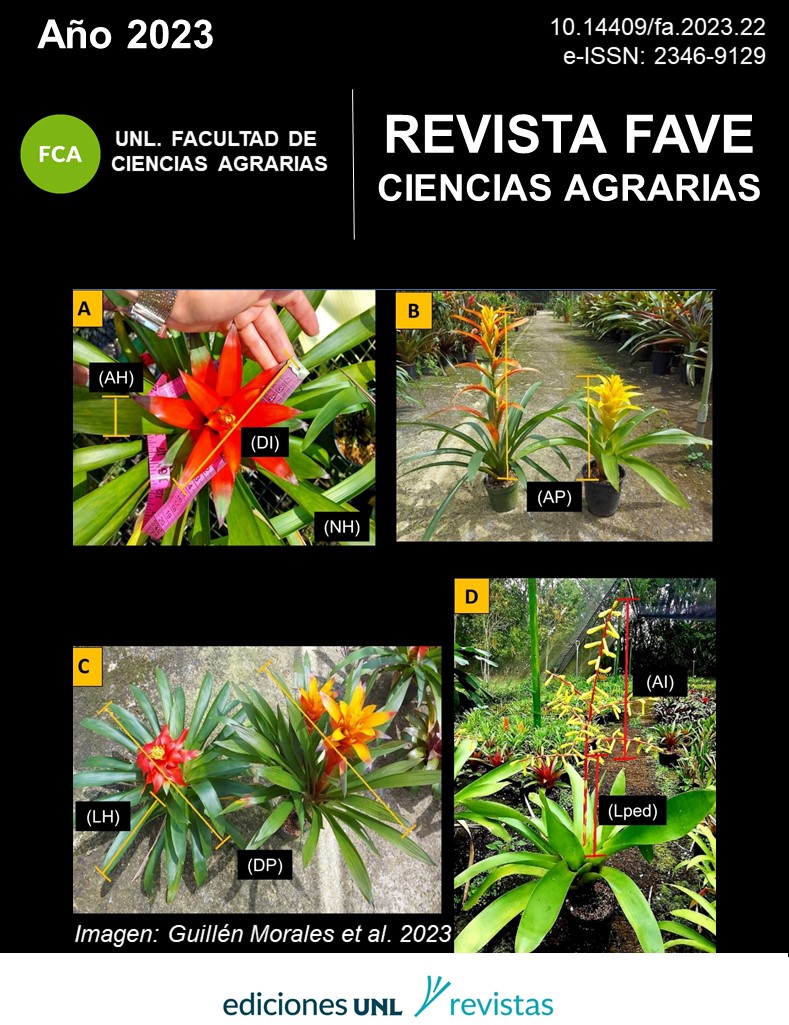Soybeans/corn index as input indicator of organic matter to the soil in argentine agriculture
DOI:
https://doi.org/10.14409/fa.2023.22.e0005Keywords:
sustainability, monoculture, stubble, carbonAbstract
Currently, Argentine agriculture is based on a simplified and high-productivity technological model, marked by the trend towards soybean monoculture. These systems with little contribution of carbon (C) to the soil predispose it to its degradation by affecting its physical, chemical and biological properties. In contrast, the crops in the sequence of a rotation differ in the quantity and quality of the stubble they leave in the soil. In the rotation with a higher frequency of grasses than soybeans, the C balance is positive, while in a rotation with a higher frequency of soybeans, the balances are negative. The objective of this analysis is to compare the relationship between the areas dedicated to farming soybeans and corn, as an indicator of risk in the reduction of the contribution of C of the crops and of the levels of organic matter of the agricultural soils of the Argentine Republic. The Soybean/Corn Index was calculated from data on official agricultural estimates. The harvested areas of soybean and corn crops were used in each department/municipality of the country and for all campaigns, from 1969/70 to 2020/21. The proposed Index was calculated for three administrative levels: national, provincial and departmental. At the national level, it increased to values close to 6, above the ideal of 1. Although in the last decade this index has been declining, still presents high values in some parts of the country. The analysis at the provincial and department/municipality level was carried out in the three main producing Argentine provinces.
References
Abbona, E., Iermanó M.J., Blandi M.L., Capparelli C., Presutti M. & Sarandón S. (2021). Utilidad de Algunos Índices de Uso Agropecuario del Suelo como Herramienta para Evaluar el Riesgo Ambiental: el Caso de la Provincia de Buenos Aires, Argentina. VIII Congreso Latinoamericano de Agroecología 2020. Sociedad Científica Latinoamericana de Agroecología. Disponible en: http://www.fagro.edu.uy/index.php/publica-sistemas-ambientales
Álvarez R & Steinbach, H. (2012). Balance de carbono en agroecosistemas. p: 231-244. En Fertilidad de suelos. Caracterización y manejo en la Región Pampeana. Eds R Álvarez; G Rubio, C Álvarez y R Lavado. FAUBA.
Beltrán, M.J., Sainz-Rozas, H. & Galantini, J.A. (2018). Cover crops in the Southeastern region of Buenos Aires, Argentina: effects on organic matter physical fractions and nutrient availability. Environ Earth Sci 77, 428. https://doi.org/10.1007/s12665-018-7606-0
Caviglia, O.P. & Andrade, F.H. (2010). Sustainable intensification of agriculture in the Argentinean Pampas: Capture and use efficiency of environmental resources. The Am J. Plant Sci. Biotech. 3 (Special Issue 1): 1-8.
Cruzate, G. A. & Casas, R. R. (2017). Balance de nutrientes en los suelos agrícolas de la Argentina en la campaña 2015/16 Informaciones Agronómicas de Hispanoamérica, N°28. http://www.ipni.net/publication/ia-lahp.nsf/issue/IA-LAHP-2017-4
Donald, C.M. (1962). In search of yield. J. Aust. Inst. Agric. Se. 28: 171-178.
Duval M. E., Galantini J.A., Iglesias JO, Canelo S; Martinez JM & L Wall. (2013). Analysis of organic fractions as indicators of soil quality under natural and cultivated systems. Soil and Tillage Research 131: 11-19.https://doi.org/10.1016/j.still.2013.03.001
Duval, M.E., Galantini, J.A., Capurro, J.E. & Martinez, J.M. (2016). Winter cover crops in soybean monoculture: Effects on soil organic carbon and its fractions, Soil and Tillage Research, Volume 161, 95-105.https://doi.org/10.1016/j.still.2016.04.006
Havlin J.L., Kissel, D.E., Maddux, L.D., Claassen, M.M. & Long, J.H. (1990). Crop rotation and tillage effects on soil organic carbon and nitrogen. Soil Sci. Soc. Am. J., 54:448-452. https://doi.org/10.2136/sssaj1990.03615995005400020026x
Jobbágy, E. G., Aguiar, S., Piñeiro, G. & Garibaldi, L. A. (2021). Impronta ambiental de la agricultura de granos en Argentina: revisando desafíos propios y ajenos. Ciencia Hoy; 29 (173); 55-64.
MAGyP. (2021). http://datosestimaciones.magyp.gob.ar/
Martínez, J.P., Barbieri, P.A., Sainz Rozas, H. R. & Echeverria, H. E. (2013) Inclusion of Cover Crops in Cropping Sequences with Soybean Predominance in the Southeast of the Humid Argentine Pampa; Bentham Open; The Open Agriculture Journal; 7; 1; 2-2013; 3-10. http://hdl.handle.net/11336/105917
Martínez, J.P.,Crespo, C., Sainz Rozas, H.R.,Echeverría, H.E.,Studdert, G.A., Martínez, F., Cordone, G. & PA Barbieri, P.A.(2019). Soil organic carbon in cropping sequences with predominance of soya bean in the argentinean humid Pampas. Soil Use and Management. 36-1:173-183. https://doi.org/10.1111/sum.12547
Martínez-Ghersa, M. A. & Ghersa, C. (2005). Consecuencias de los recientes cambios agrícolas, en: Oesterheld, M. (ed) La Transformación de la Agricultura Argentina, Ciencia Hoy.Vol 15 N° 87 .37-45.
Murgida, A. M., Travasso, M. I., González, S. & Rodriguez, G. R. (2014). Evaluación de impactos del cambio climático sobre la producción agrícola en la Argentina. CEPAL - Serie Medio Ambiente y Desarrollo N° 155.
Novelli, N.E. (2013) Intensificación de las secuencias de cultivos en un Molisol y un Vertisol: cambios en la estabilidad estructural y en el almacenaje de C en agregados Tesis doctoral Universidad de Buenos Aires. Biblioteca virtual: http://ri.agro.uba.ar/files/download/tesis/doctorado/2013novellileonardoesteban.pdf
Presutti Miriam. (2021). Balance de nutrientes en la agricultura extensiva bonaerense para la campaña 2019/20. Revista MDA. Vol 2 N. º 2. 43-50. https://www.gba.gob.ar/desarrollo_agrario/revista_mda
Sainz Rozas H.R., Echeverría, H.E. & Angelini, H. (2011). Niveles de materia orgánica y pH en suelos agrícolas de la Región Pampeana y Extrapampeana Argentina.Informaciones Agronómicas de Hispanoamérica (LACS). International Plant Nutrition Institute (IPNI).
Sainz Rozas H.R., Eyherabide, M., Larrea, G., Martinez Cuesta N., Angelini, H., Reussi Calvo, N. & Wyngaard, N. (2019), Relevamiento y determinación de propiedades químicas en suelos de aptitud agrícola de la región pampeana. Simposio Fertilizar. https://fertilizar.org.ar/wp-content/uploads/2021/02/SAINZ-ROZAS-Fertilidad-2019-acta.pdf
Satorre, E. (2005). Cambios tecnológicos en la agricultura argentina actual En: Oesterheld, M. (ed.), La Transformación de la Agricultura Argentina, Ciencia Hoy, Vol 15 N° 87. 24-31.
Senasa. (2021) CARACTERIZACIÓN DE ESTABLECIMIENTOS DE ENGORDE A CORRAL. SEPTIEMBRE 2021. Acceso 20 abril 2022.https://www.argentina.gob.ar/sites/default/files/82a-informe_feed_lot_septiembre_2021-26-10_final.pdf
Studdert, G., & Echeverría, H. (2000) Crop rotations and nitrogen fertilization to manage soil organic carbon dynamics. Soil Sci. Soc. Am. J. 64:1496-1503.https://doi.org/10.2136/sssaj2000.6441496.

















